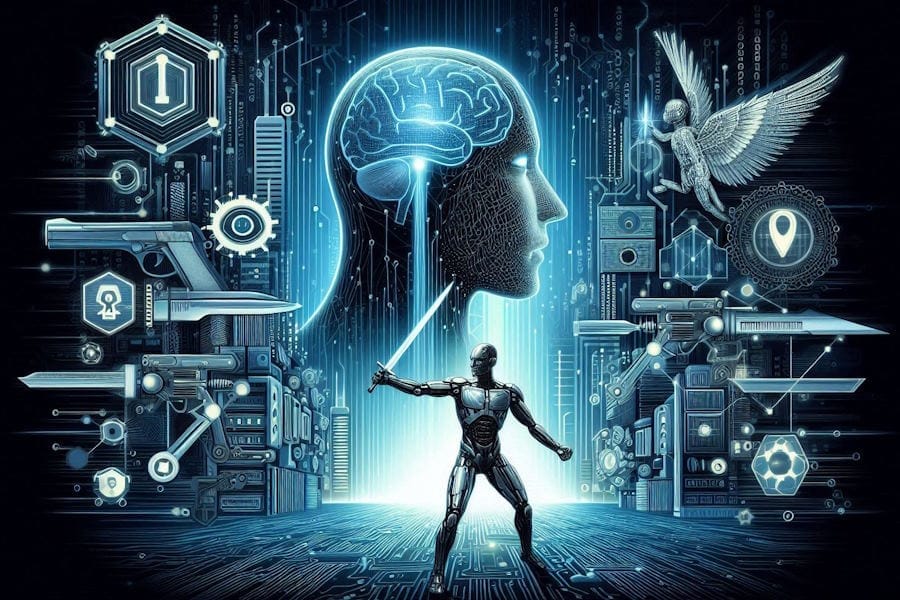Type: Article -> Category: AI Education
The Evolution of Cybersecurity in the Age of AI
A Double-Edged Sword

Publish Date: Last Updated: 10th November 2025
Author: nick smith- With the help of CHATGPT
Artificial Intelligence (AI) is reshaping the landscape of cybersecurity, introducing both groundbreaking defenses and sophisticated threats. As organizations increasingly rely on digital infrastructure, the battle between cyber defenders and malicious actors has intensified, evolving into a high-stakes race powered by AI. This article delves into the positive and negative aspects of AI's influence on cybersecurity, highlighting how this technological arms race shapes the ongoing struggle between good and evil in the digital realm.
The Positive Impact: AI as a Shield
1. Enhanced Threat Detection and Response
AI-driven cybersecurity tools excel at processing vast amounts of data in real-time, enabling the rapid detection of anomalies and potential threats. Machine learning algorithms analyze patterns and behaviors across networks, identifying suspicious activities that may indicate cyber attacks. This proactive approach allows for quicker response times, reducing the window of opportunity for attackers to exploit vulnerabilities.
2. Automation of Routine Security Tasks
AI automates repetitive and time-consuming security tasks such as monitoring network traffic, managing patches, and updating security protocols. By handling these routine duties, AI frees up cybersecurity professionals to focus on more complex issues, strategic planning, and threat mitigation. Automation increases efficiency and ensures that security measures are consistently applied across the entire digital infrastructure.
3. Predictive Analytics for Anticipating Threats
Through predictive analytics, AI can forecast potential cyber threats by analyzing historical data and recognizing patterns that precede attacks. This foresight enables organizations to bolster their defenses proactively, patch vulnerabilities before they are exploited, and prepare contingency plans for anticipated threats. Predictive capabilities are crucial for staying one step ahead in the ever-evolving cyber threat landscape.
4. Improved User Authentication
AI enhances user authentication processes through biometric verification, behavioral analysis, and anomaly detection. Techniques such as facial recognition, fingerprint scanning, and voice recognition add layers of security beyond traditional passwords. AI algorithms can detect unusual login behaviors, such as access attempts from different geographical locations within a short time frame, and trigger additional authentication measures.
The Negative Impact: AI as a Weapon
1. Advanced AI-Powered Cyber Attacks
Malicious actors harness AI to develop more sophisticated cyber attacks that are harder to detect and defend against. AI-driven malware can adapt to security measures, learn from environments, and modify its behavior to avoid detection. These smart attacks pose significant challenges to traditional cybersecurity defenses, as they can evolve rapidly and target specific vulnerabilities with precision.
2. Deepfakes and Social Engineering
AI technologies enable the creation of deepfakes—highly realistic but fake audio, video, or images—that can be used to deceive individuals and organizations. Deepfakes facilitate advanced social engineering attacks by impersonating trusted individuals, such as executives or business partners, to manipulate targets into divulging sensitive information or transferring funds.
3. AI-Enhanced Phishing Attacks
Cybercriminals use AI to craft highly personalized phishing emails that are more convincing and harder to identify as fraudulent. By analyzing publicly available information and social media profiles, AI algorithms can generate messages tailored to the recipient's interests, behaviors, and relationships, increasing the likelihood of successful deception.
4. Weaponization of AI Bots
Bots powered by AI can launch large-scale automated attacks, such as Distributed Denial of Service (DDoS) attacks, overwhelming systems and causing significant disruptions. These bots can also be programmed to scan for vulnerabilities across the internet, enabling cybercriminals to identify and exploit weaknesses in a vast number of systems quickly.
The Arms Race: Good vs. Evil in Cyberspace
The interplay between AI's defensive and offensive capabilities has transformed cybersecurity into a dynamic arms race. As defenders adopt AI to strengthen security measures, attackers respond by leveraging AI to circumvent defenses and exploit new vulnerabilities. This continuous cycle drives innovation on both sides, escalating the complexity and scale of cyber threats.
Challenges for Cyber Defenders
- Resource Limitations: Cybersecurity teams often face constraints in budget, personnel, and expertise, making it difficult to keep pace with well-funded and skilled adversaries utilizing AI.
- Ethical Considerations: Defenders must operate within legal and ethical boundaries, while attackers have no such limitations, allowing them to experiment freely with malicious AI applications.
- Rapid Evolution of Threats: AI enables threats to evolve quickly, requiring constant updates to security protocols and tools, which can strain organizational resources.
Strategies for Strengthening Defenses
- Collaborative Efforts: Sharing information about threats and vulnerabilities among organizations and security communities enhances collective defenses against AI-driven attacks.
- Investment in AI Research: Supporting AI research focused on cybersecurity helps develop advanced tools and methodologies to detect and counter sophisticated threats.
- Regulatory Frameworks: Implementing regulations that govern the use of AI can help mitigate risks associated with malicious applications while promoting responsible innovation.
Conclusion
AI's dual role in cybersecurity as both a shield and a sword underscores the technology's profound impact on the digital landscape. While AI offers powerful tools for enhancing security and protecting assets, it also provides adversaries with means to conduct more effective and damaging attacks. Navigating this complex environment requires vigilance, continuous innovation, and a commitment to ethical practices.
Organizations must embrace AI's defensive capabilities while remaining aware of its potential misuse. By fostering collaboration, investing in advanced security solutions, and promoting a culture of cybersecurity awareness, it is possible to tip the balance in favor of the good in this high-stakes race. The evolution of cybersecurity in relation to AI is a testament to the enduring struggle between innovation for protection and exploitation, reflecting the broader challenges society faces in the digital age.
AI Cyber Security from YouTube

Impact of Artificial Intelligence AI on Cybersecurity
YouTube Channel: Eretmis Cybersecurity (Eretmis Academy)

Agentic AI Meets Cybersecurity + Solar Robots in the Desert | E2125
YouTube Channel: This Week in Startups

this is a huge problem for cybersecurity...
YouTube Channel: Low Level

Cybersecurity Today: Virtual Employees, AI Security Agents, and CVE Program Updates
YouTube Channel: TechNewsDay1

AI vs. Hackers: The New Battlefield in Cybersecurity
YouTube Channel: HawkTech - Your Cyber Guard

AI Cybersecurity for Product Managers - AI PM Community Session #79
YouTube Channel: Product Management Exercises

Jay DePaul on Cyber Security Awareness AI Training
YouTube Channel: Dun & Bradstreet

2025 Threat Intelligence Index: Dark Web, AI, & Ransomware Trends
YouTube Channel: IBM Technology
Latest AI Articles
AI Questions and Answers section for The Evolution of Cybersecurity in the Age of AI: A Double-Edged Sword
Welcome to a new feature where you can interact with our AI called Jeannie. You can ask her anything relating to this article. If this feature is available, you should see a small genie lamp above this text. Click on the lamp to start a chat or view the following questions that Jeannie has answered relating to The Evolution of Cybersecurity in the Age of AI: A Double-Edged Sword.
Be the first to ask our Jeannie AI a question about this article
Look for the gold latern at the bottom right of your screen and click on it to enable Jeannie AI Chat.
Type: Article -> Category: AI Education










